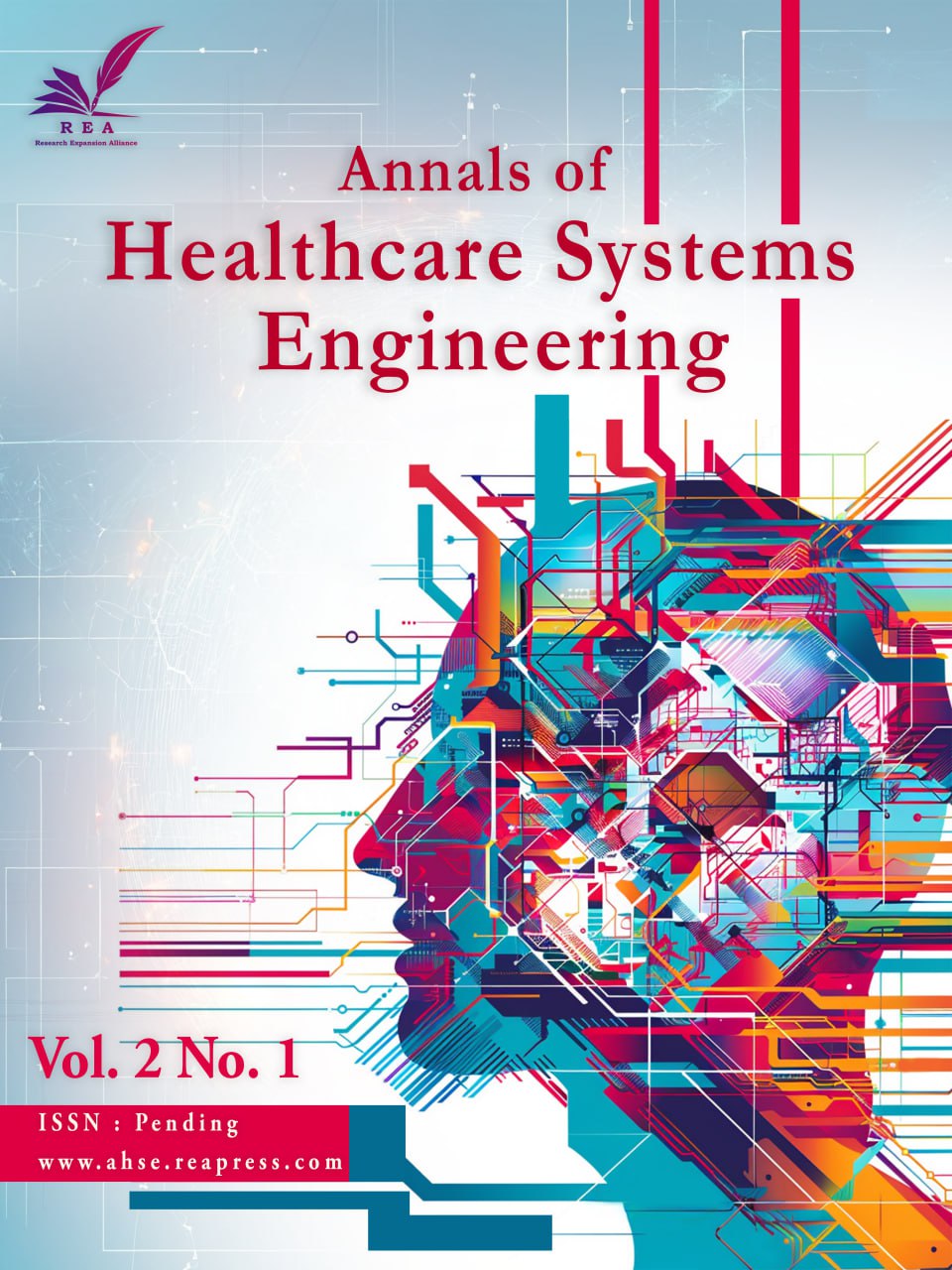A Systemic Review on the Adoption of Particle Swarm Optimization Algorithms in Biomedical Engineering Diagnostics and Simulations
Abstract
In biomedical engineering, Particle Swarm Optimization (PSO) algorithms have been increasingly adopted for diagnostics and simulations due to their ability to optimize parameters and improve the accuracy of results effectively. Despite the growing interest in the adoption of PSO algorithms in biomedical engineering, there is a lack of comprehensive understanding of their effectiveness and limitations in diagnostics and simulations. Existing studies have focused on specific applications or case studies. Still, there is a need for a systematic review to synthesize the current state of knowledge and provide insights into the potential benefits and challenges of using PSO algorithms in this context. This study adopted a systematic review comprising a rigorous methodology to identify relevant studies on adopting PSO algorithms in biomedical engineering diagnostics and simulations. A comprehensive search strategy was also developed to identify relevant literature from significant databases. The findings revealed that PSO algorithms have been successfully applied in various biomedical applications, including image processing, signal analysis, and medical image reconstruction. This study reported improvements in accuracy, efficiency, and robustness compared to traditional optimization methods, highlighting the potential of PSO algorithms in enhancing the performance of biomedical engineering systems. The findings suggest that PSO algorithms have the potential to significantly improve the accuracy and efficiency of biomedical engineering systems, but further research is needed to address the challenges and limitations associated with their implementation.
Keywords:
Particle swarm optimization, Biomedical engineering, Algorithms, Diagnostics, SimulationsReferences
- [1] Mohd Yamin, M. N., Ab. Aziz, K., Siang, T. G., & Ab. Aziz, N. A. (2023). Particle swarm optimisation for emotion recognition systems: A decade review of the literature. Applied sciences, 13(12), 7054. https://doi.org/10.3390/app13127054
- [2] Gad, A. G. (2022). Particle swarm optimization algorithm and its applications: A systematic review. Archives of computational methods in engineering, 29(5), 2531–2561. https://doi.org/10.1007/s11831-021-09694-4
- [3] Wang, D., Tan, D., & Liu, L. (2018). Particle swarm optimization algorithm: An overview. Soft computing, 22(2), 387–408. https://doi.org/10.1007/s00500-016-2474-6
- [4] Lameesa, A., Hoque, M., Alam, M. S. B., Ahmed, S. F., & Gandomi, A. H. (2024). Role of metaheuristic algorithms in healthcare: a comprehensive investigation across clinical diagnosis, medical imaging, operations management, and public health. Journal of computational design and engineering, 11(3), 223–247. https://doi.org/10.1093/jcde/qwae046
- [5] Ikpe, A. E., Ohwoekevwo, J. U., & Ekanem, I. I. (2024). Overview of the role of medical robotics in day-to-day healthcare services: A paradigm shift in clinical operations. Ibom medical journal, 17(2), 192–203. https://doi.org/10.61386/imj.v7i2.422
- [6] de Melo Menezes, B. A., Kuchen, H., & Buarque de Lima Neto, F. (2022). Parallelization of swarm intelligence algorithms: Literature review. International journal of parallel programming, 50(5), 486–514. https://doi.org/10.1007/s10766-022-00736-3
- [7] Sun, Y., Chu, S. C., Hu, P., Watada, J., Si, M., & Pan, J. S. (2022). Overview of parallel computing for meta-heuristic algorithms. Journal of network intelligence, 7(3), 656–684. https://bit.kuas.edu.tw/~jni/2022/vol7/s3/08.JNI0353_r2.pdf
- [8] Houssein, E. H., Hosney, M. E., Emam, M. M., Younis, E. M. G., Ali, A. A., & Mohamed, W. M. (2023). Soft computing techniques for biomedical data analysis: Open issues and challenges. Artificial intelligence review, 56(2), 2599–2649. https://doi.org/10.1007/s10462-023-10585-2
- [9] Rundo, L., Militello, C., Vitabile, S., Russo, G., Sala, E., & Gilardi, M. C. (2019). A survey on nature-inspired medical image analysis: A step further in biomedical data integration. Fundamenta informaticae, 171(1–4), 345–365. https://doi.org/10.3233/FI-2020-1887
- [10] Beni, G. (2020). Swarm intelligence. In complex social and behavioral systems : Game theory and agent-based models (pp. 791–818). Springer US. https://doi.org/10.1007/978-1-0716-0368-0_530
- [11] Shahzad, M. M., Saeed, Z., Akhtar, A., Munawar, H., Yousaf, M. H., Baloach, N. K., & Hussain, F. (2023). A review of swarm robotics in a nutshell. Drones, 7(4), 269. https://doi.org/10.3390/drones7040269
- [12] Sengupta, S., Basak, S., & Peters, R. A. (2018). Particle swarm optimization: A survey of historical and recent developments with hybridization perspectives. Machine learning and knowledge extraction, 1(1), 157–191. https://doi.org/10.3390/make1010010
- [13] Tian, D., & Shi, Z. (2018). MPSO: Modified particle swarm optimization and its applications. Swarm and evolutionary computation, 41, 49–68. https://doi.org/10.1016/j.swevo.2018.01.011
- [14] Yadav, R. K., & Anubhav. (2020). PSO-GA based hybrid with adam optimization for ANN training with application in medical diagnosis. Cognitive systems research, 64, 191–199. https://doi.org/10.1016/j.cogsys.2020.08.011
- [15] Zhang, T., Zhou, P., Zhang, S., Cheng, S., Ma, L., Jiang, H., & Yao, Y.-D. (2024). Bio-inspired optimisation algorithms in medical image segmentation: A review. International journal of bio-inspired computation, 24(2), 65–79. https://doi.org/10.1504/IJBIC.2024.141449
- [16] Saifullah, S., & Dreżewski, R. (2024). Advanced medical image segmentation enhancement: A particle-swarm-optimization-based histogram equalization approach. Applied sciences, 14(2), 923. https://doi.org/10.3390/app14020923
- [17] Khare, A., & Rangnekar, S. (2013). A review of particle swarm optimization and its applications in solar photovoltaic system. Applied soft computing, 13(5), 2997–3006. https://doi.org/10.1016/j.asoc.2012.11.033
- [18] Zhang, Y., Wang, S., & Ji, G. (2015). A comprehensive survey on particle swarm optimization algorithm and its applications. Mathematical problems in engineering, 2015(1), 931256. https://doi.org/10.1155/2015/931256
- [19] Fei, Z., Li, B., Yang, S., Xing, C., Chen, H., & Hanzo, L. (2017). A survey of multi-objective optimization in wireless sensor networks: Metrics, algorithms, and open problems. IEEE communications surveys & tutorials, 19(1), 550–586. https://doi.org/10.1109/COMST.2016.2610578
- [20] Suriyan, K., & Nagarajan, R. (2024). Particle swarm optimization in biomedical technologies: Innovations, challenges, and opportunities. In emerging technologies for health literacy and medical practice (pp. 220–238). IGI Global Scientific Publishing. https://doi.org/10.4018/979-8-3693-1214-8.ch011
- [21] Jain, M., Saihjpal, V., Singh, N., & Singh, S. B. (2022). An overview of variants and advancements of PSO algorithm. Applied sciences, 12(17), 8392. https://doi.org/10.3390/app12178392
- [22] Harrison, K. R., Engelbrecht, A. P., & Ombuki-Berman, B. M. (2018). Self-adaptive particle swarm optimization: A review and analysis of convergence. Swarm intelligence, 12(3), 187–226. https://doi.org/10.1007/s11721-017-0150-9
- [23] Xu, M., Cao, L., Lu, D., Hu, Z., & Yue, Y. (2023). Application of swarm intelligence optimization algorithms in image processing: A comprehensive review of analysis, synthesis, and optimization. Biomimetics, 8(2), 235. https://doi.org/10.3390/biomimetics8020235
- [24] Razzak, M. I., Naz, S., & Zaib, A. (2018). Deep learning for medical image processing: Overview, challenges and the future. In classification in bioapps: Automation of decision making (pp. 323–350). Cham: Springer, Cham. https://doi.org/10.1007/978-3-319-65981-7_12
- [25] Bangyal, W. H., Nisar, K., Ag. Ibrahim, A. A. B., Haque, M. R., Rodrigues, J. J. P. C., & Rawat, D. B. (2021). Comparative analysis of low discrepancy sequence-based initialization approaches using population-based algorithms for solving the global optimization problems. Applied sciences, 11(16), 7591. https://doi.org/10.3390/app11167591
- [26] Ibrahim, F., Thio, T. H. G., Faisal, T., & Neuman, M. (2015). The application of biomedical engineering techniques to the diagnosis and management of tropical diseases: A review. Sensors, 15(3), 6947–6995. https://doi.org/10.3390/s150306947
- [27] Garcia-Gonzalo, E., & Fernandez-Martinez, J. L. (2012). A brief historical review of particle swarm optimization (PSO). Journal of bioinformatics and intelligent control, 1(1), 3–16. http://dx.doi.org/10.1166/jbic.2012.1002
- [28] Martí, L., García, J., Berlanga, A., & Molina, J. M. (2016). A stopping criterion for multi-objective optimization evolutionary algorithms. Information sciences, 367–368, 700–718. https://doi.org/10.1016/j.ins.2016.07.025
- [29] Juneja, M., & Nagar, S. K. (2016). Particle swarm optimization algorithm and its parameters: A review. 2016 international conference on control, computing, communication and materials (ICCCCM) (pp. 1–5). IEEE. https://doi.org/10.1109/ICCCCM.2016.7918233
- [30] Rini, D. P., Shamsuddin, S. M., & Yuhaniz, S. S. (2011). Particle swarm optimization: Technique, system and challenges. International journal of computer applications, 14(1), 19–26. http://dx.doi.org/10.5120/ijais-3651
- [31] Kainz, W., Neufeld, E., Bolch, W. E., Graff, C. G., Kim, C. H., Kuster, N., … ., & Tsui, B. M. W. (2019). Advances in computational human phantoms and their applications in biomedical engineering—a topical review. IEEE transactions on radiation and plasma medical sciences, 3(1), 1–23. https://doi.org/10.1109/TRPMS.2018.2883437
- [32] Parsopoulos, K. E., & Vrahatis, M. N. (2002). Recent approaches to global optimization problems through particle swarm optimization. Natural computing, 1(2), 235–306. https://doi.org/10.1023/A:1016568309421
- [33] Rezaei, F., & Safavi, H. R. (2020). GuASPSO: A new approach to hold a better exploration–exploitation balance in PSO algorithm. Soft computing, 24(7), 4855–4875. https://doi.org/10.1007/s00500-019-04240-8
- [34] Marini, F., & Walczak, B. (2015). Particle swarm optimization (PSO). A tutorial. Chemometrics and intelligent laboratory systems, 149, 153–165. https://doi.org/10.1016/j.chemolab.2015.08.020
- [35] Alswaitti, M., Albughdadi, M., & Isa, N. A. M. (2018). Density-based particle swarm optimization algorithm for data clustering. Expert systems with applications, 91, 170–186. https://doi.org/10.1016/j.eswa.2017.08.050
- [36] Benuwa, B. B., Ghansah, B., Wornyo, D. K., & Adabunu, S. A. (2016). A comprehensive review of particle swarm optimization. International journal of engineering research in Africa, 23, 141–161. https://doi.org/10.4028/www.scientific.net/JERA.23.141
- [37] Mavrovouniotis, M., Li, C., & Yang, S. (2017). A survey of swarm intelligence for dynamic optimization: Algorithms and applications. Swarm and evolutionary computation, 33, 1–17. https://doi.org/10.1016/j.swevo.2016.12.005
- [38] Sharma, A., Sharma, A., Jately, V., Averbukh, M., Rajput, S., & Azzopardi, B. (2022). A novel TSA-PSO based hybrid algorithm for GMPP tracking under partial shading conditions. Energies, 15(9), 3164. https://doi.org/10.3390/en15093164
- [39] Kessentini, S., & Barchiesi, D. (2015). Particle swarm optimization with adaptive inertia weight. International journal of machine learning and computing, 5(5), 368-373. https://doi.org/10.7763/IJMLC.2015.V5.535
- [40] Yue, W., Jin, G., & Yang, X. (2022). Adaptive particle swarm optimization for automatic design of common aperture optical system. Photonics, 9(11), 807. https://doi.org/10.3390/photonics9110807
- [41] Fallahi, S., & Taghadosi, M. (2022). Quantum-behaved particle swarm optimization based on solitons. Scientific reports, 12(1), 13977. https://doi.org/10.1038/s41598-022-18351-0
- [42] Bhatia, A. S., Saggi, M. K., & Zheng, S. (2020). QPSO-CD: Quantum-behaved particle swarm optimization algorithm with cauchy distribution. Quantum information processing, 19(10), 345. https://doi.org/10.1007/s11128-020-02842-y
- [43] Patil, D. D., & Dangewar, B. D. (2014). Multi-objective particle swarm optimization (MOPSO) based on pareto dominance approach. International journal of computer applications, 107(4). http://dx.doi.org/10.5120/18738-9983
- [44] Sun, Y., & Gao, Y. (2019). A multi-objective particle swarm optimization algorithm based on gaussian mutation and an improved learning strategy. Mathematics, 7(2), 148. https://doi.org/10.3390/math7020148
- [45] Mirsadeghi, E., & Khodayifar, S. (2021). Hybridizing particle swarm optimization with simulated annealing and differential evolution. Cluster computing, 24(2), 1135–1163. https://doi.org/10.1007/s10586-020-03179-y
- [46] Guo, E., Gao, Y., Hu, C., & Zhang, J. (2023). A hybrid PSO-DE intelligent algorithm for solving constrained optimization problems based on feasibility rules. Mathematics, 11(3), 522. https://doi.org/10.3390/math11030522
- [47] Brezočnik, L., Fister, I., & Podgorelec, V. (2018). Swarm intelligence algorithms for feature selection: A review. Applied sciences, 8(9), 1521. https://doi.org/10.3390/app8091521
- [48] Ahmad, I. (2015). Feature selection using particle swarm optimization in intrusion detection. International journal of distributed sensor networks, 11(10), 806954. http://dx.doi.org/10.1155/2015/806954
- [49] Xue, B., Zhang, M., & Browne, W. N. (2012). New fitness functions in binary particle swarm optimisation for feature selection. 2012 IEEE congress on evolutionary computation (pp. 1–8). IEEE. https://doi.org/10.1109/CEC.2012.6256617
- [50] Tang, J., Liu, G., & Pan, Q. (2021). A review on representative swarm intelligence algorithms for solving optimization problems: Applications and trends. IEEE/CAA journal of automatica Sinica, 8(10), 1627–1643. https://doi.org/10.1109/JAS.2021.1004129
- [51] Esmin, A. A., Coelho, R. A., & Matwin, S. (2015). A review on particle swarm optimization algorithm and its variants to clustering high-dimensional data. Artificial intelligence review, 44(1), 23–45. https://doi.org/10.1007/s10462-013-9400-4
- [52] Rezaee Jordehi, A., & Jasni, J. (2013). Parameter selection in particle swarm optimisation: A survey. Journal of experimental & theoretical artificial intelligence, 25(4), 527–542. https://doi.org/10.1080/0952813X.2013.782348
- [53] Nickabadi, A., Ebadzadeh, M. M., & Safabakhsh, R. (2011). A novel particle swarm optimization algorithm with adaptive inertia weight. Applied soft computing, 11(4), 3658–3670. https://doi.org/10.1016/j.asoc.2011.01.037
- [54] Sankaran, K. S., & Kim, J. (2022). Efficient and optimized communication in biomedical sensor networks based on bioinspired particle swarm optimization for medical applications. Medical engineering & physics, 110, 103922. https://doi.org/10.1016/j.medengphy.2022.103922
- [55] Fan, H. (2002). A modification to particle swarm optimization algorithm. Engineering computations, 19(8), 970–989. https://doi.org/10.1108/02644400210450378
- [56] Lessmann, S., Caserta, M., & Arango, I. M. (2011). Tuning metaheuristics: A data mining based approach for particle swarm optimization. Expert systems with applications, 38(10), 12826–12838. https://doi.org/10.1016/j.eswa.2011.04.075
- [57] Chawla, M., & Duhan, M. (2014). Applications of recent metaheuristics optimisation algorithms in biomedical engineering: A review. International journal of biomedical engineering and technology, 16(3), 268–278. https://doi.org/10.1504/IJBET.2014.065807
- [58] del Valle, Y., Venayagamoorthy, G. K., Mohagheghi, S., Hernandez, J. C., & Harley, R. G. (2008). Particle swarm optimization: Basic concepts, variants and applications in power systems. IEEE transactions on evolutionary computation, 12(2), 171–195. https://doi.org/10.1109/TEVC.2007.896686
- [59] Li, X., & Engelbrecht, A. P. (2007). Particle swarm optimization: An introduction and its recent developments. Proceedings of the 9th annual conference companion on genetic and evolutionary computation (pp. 3391–3414). Association for Computing Machinery. https://doi.org/10.1145/1274000.1274118
- [60] Gang, M., Wei, Z., & Xiaolin, C. (2012). A novel particle swarm optimization algorithm based on particle migration. Applied mathematics and computation, 218(11), 6620–6626. https://doi.org/10.1016/j.amc.2011.12.032
- [61] Ab Wahab, M. N., Nefti-Meziani, S., & Atyabi, A. (2015). A comprehensive review of swarm optimization algorithms. PloS one, 10(5), e0122827. https://doi.org/10.1371/journal.pone.0122827
- [62] Azadifar, S., & Ahmadi, A. (2021). A graph-based gene selection method for medical diagnosis problems using a many-objective PSO algorithm. BMC medical informatics and decision making, 21(1), 333. https://doi.org/10.1186/s12911-021-01696-3
- [63] Thangamani, M., Satheesh, S., Lingisetty, R., Rajendran, S., & Shivahare, B. D. (2025). Mathematical model for swarm optimization in multimodal biomedical images. In swarm optimization for biomedical applications (pp. 86–107). CRC Press. https://doi.org/10.1201/9781032713762
- [64] Kaur, S., Kumar, Y., Koul, A., & Kumar Kamboj, S. (2023). A systematic review on metaheuristic optimization techniques for feature selections in disease diagnosis: Open issues and challenges. Archives of computational methods in engineering, 30(3), 1863–1895. https://doi.org/10.1007/s11831-022-09853-1
- [65] Lalwani, S., Singhal, S., Kumar, R., & Gupta, N. (2013). A comprehensive survey: Applications of multi-objective particle swarm optimization (MOPSO) algorithm. Transactions on combinatorics, 2(1), 39–101. https://doi.org/10.22108/toc.2013.2834
- [66] Agarwal, S., Rani, N., & Vajpayee, A. (2024). Bioinspired algorithms: opportunities and challenges. In bio-inspired optimization for medical data mining (pp. 1–30). Wiley Online Library. https://doi.org/10.1002/9781394214211.ch1
- [67] Kaur, P., & Singh, R. K. (2023). A review on optimization techniques for medical image analysis. Concurrency and computation: Practice and experience, 35(1), e7443. https://doi.org/10.1002/cpe.7443
- [68] Kaur, S., & Singh, J. (2023). Enhancing medical image analysis and disease surveillance in healthcare: A study on pso- aco optimization using swarm intelligence. 2023 2nd international conference on computational modelling, simulation and optimization (ICCMSO) (pp. 269–276). IEEE. https://doi.org/10.1109/ICCMSO59960.2023.00058
- [69] Ul Haq, I. (2024). Diagnosis of neurological disease using bioinspired algorithms. In bio-inspired optimization for medical data mining (pp. 227–268). Wiley Online Library. https://doi.org/10.1002/9781394214211.ch12
- [70] Casson, C. L., John, S. A., & Ferrall-Fairbanks, M. C. (2023). Mathematical modeling of cardio-oncology: Modeling the systemic effects of cancer therapeutics on the cardiovascular system. Seminars in cancer biology, 97, 30–41. https://doi.org/10.1016/j.semcancer.2023.11.004
- [71] Peto, M., García-Ávila, J., Rodriguez, C. A., Siller, H. R., da Silva, J. V. L., & Ramírez-Cedillo, E. (2024). Review on structural optimization techniques for additively manufactured implantable medical devices. Frontiers in mechanical engineering, 10, 1353108. https://doi.org/10.3389/fmech.2024.1353108
- [72] Candia, D. A., Játiva, P. P., Azurdia Meza, C., Sánchez, I., & Ijaz, M. (2024). Performance analysis of the particle swarm optimization algorithm in a VLC system for localization in hospital environments. Applied sciences, 14(6), 2514. https://doi.org/10.3390/app14062514




